"Luther’s first translation of the entire New Testament ['Das Newe Testament Deutzsch'] from the Greek original was published by Melchior Lotter the Younger in September 1522, with woodcut illustrations by Lucas Cranach. The so-called September Testament was received so enthusiastically that a second edition with corrections by Luther was printed as early as December of the same year.
Not only is the September Testament regarded as a milestone in the history of German Bible translation, but also it had an unequalled hand in the promotion of the Reformation, as well as in the dissemination of the High German language. Numerous reprints bear witness to its success: 12 editions were published in Basel, Augsburg, Grimma and Leipzig during the year 1523 alone."
The quote above comes from the Dr. Jörn Günther • Antiquariat site. That summary is relevant here but I'm fairly confident that their edition is a much more valuable, gold-highlighted work by a superior artist. However, the woodcut designs are indentical in both versions and were produced by the artist, Georg Lemberger {his initials are seen in that final image above}.
"For the Apocalypse, Lemberger took Cranach’s compositions as models, complementing them with new illustrations. With a total of 44 full-page images [printed from 34 blocks] plus 27 larger initials and the border decoration of the title page, this edition is lavishly illustrated. The Gospels are introduced with portraits of their authors, the Epistles with images of the apostles, and thus each book of the New Testament begins with a woodcut.
The artist renders the evangelists as hermits placing them in a wilderness setting, while he shows the apostles in the act of handing over their letters to messengers who depart into wooded, mountainous landscapes. The halos of the apostles are rendered as spectacular, luminous apparitions.The figures are depicted in close-up before landscapes featuring low horizons and woody or rocky mountains. A typical element is the large conifers stretching out their long branches."
- The book is owned and hosted by Mälardalen University in Sweden [trans.]. BE WARNED: the only way to view this book is to load the whole thing, all 66Mb in Shockwave format, which will probably require a plugin/upgrade and maybe a restart as well. {Link: "Das newe testament deutzsch - Luther, Martin"}
- All of the images above were spliced together from screencaps. Obviously the selection is skewed in favour of the more twisted/sensational/monstrous, as is my want. The balance of the illustrations has been saved in this set. Of particular note: the title page; full double-page appearance: with illustration & without illustration; a duet of St Paul depictions (I erroneously thought this was evidence suggesting that the illustrations were painted miniatures rather than hand-painted woodcuts; I was to lose a bet to Laura over this, who happily supplied the Antiquariat site link to reveal my foolishness.)
- Thanks to Klaus from Archivalia for posting a multi-headed monster image: I 'pretend' I can read German (and Spanish and Dutch and ...) but the truth is, without the occasional visual alert, I'm much more likely to miss the quality material, such as the striking illustrations found in the September Testament.
- Wikipedia: Luther Bible; Martin Luther.
- New Advent: Martin Luther.
- UPDATE - just a few days after posting this entry Taschen books announced a new publication of a Luther bible ['The Bible in Pictures'] based on an edition from the Lucas Cranach workshop (1534) - the illustrations are different than those seen above. [click 'Leaf through!' to see zoomable pages and commentary] {Amazon}
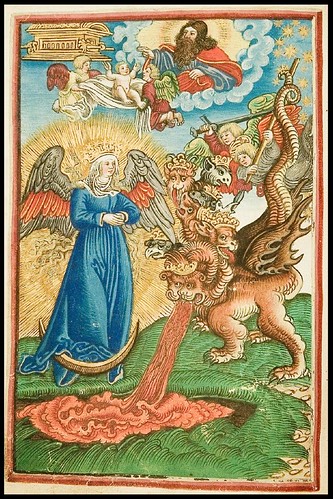
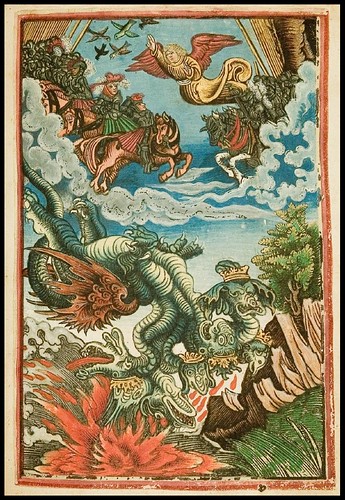

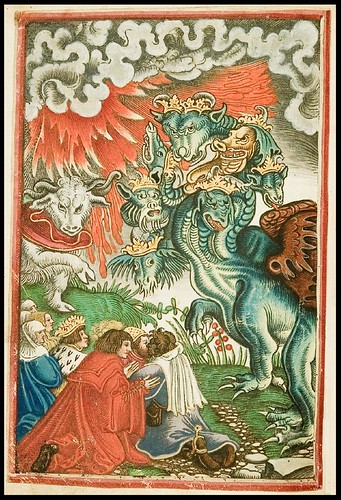
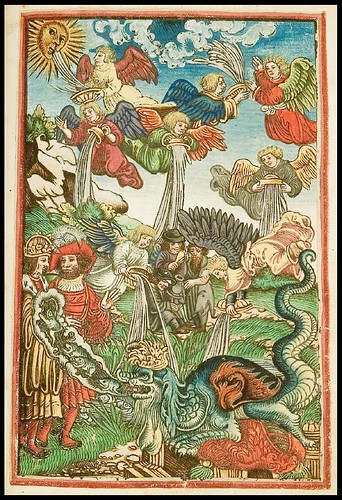

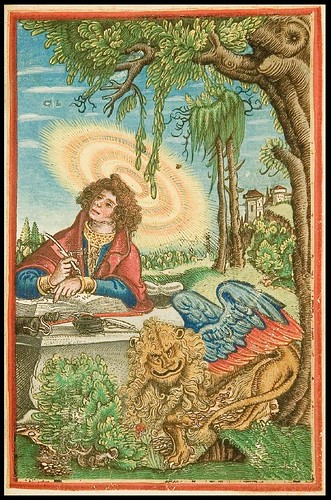
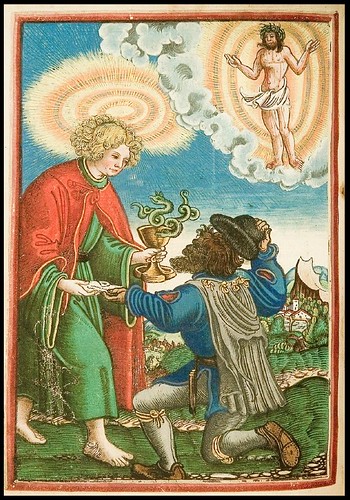
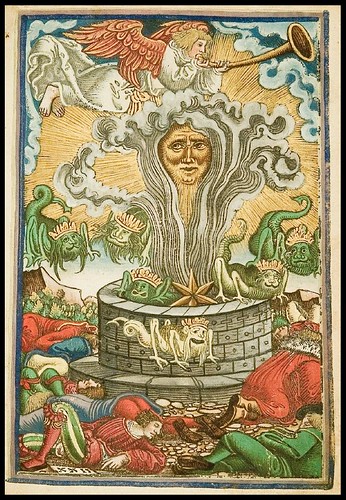
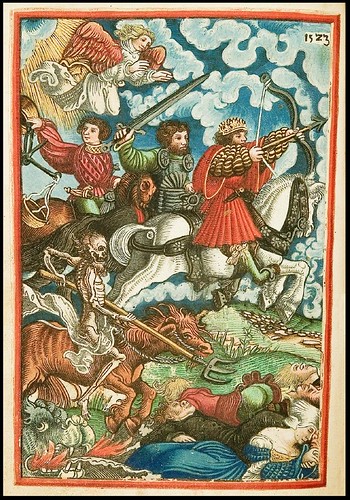
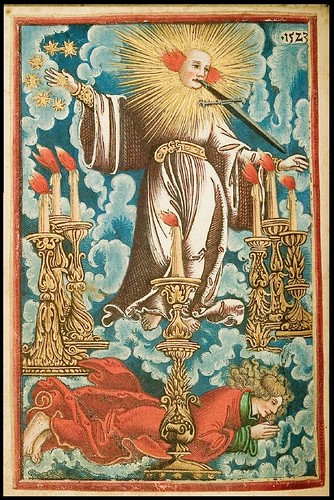
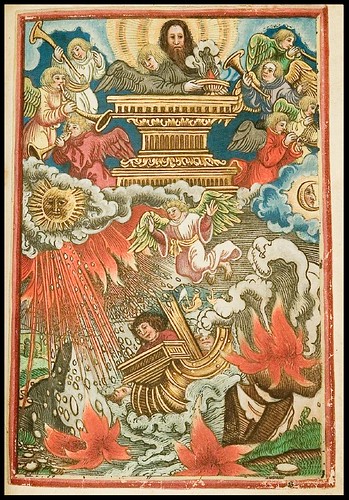
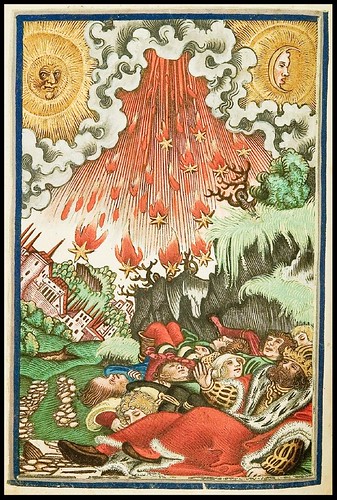
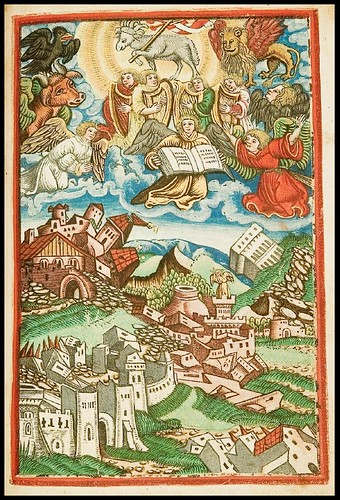
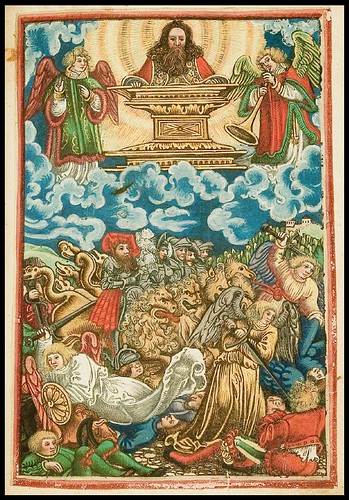
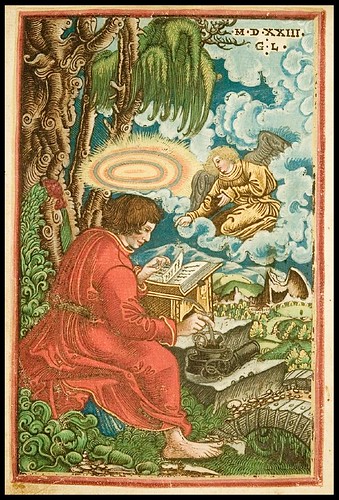



















9 comments :
i would more likely link the composition of these images to Durer's Apokalyps of 1492, rather than Cranach. The apokalyps, in turn, was informed by the Koberger Bible (for example, the style of the seven candlesticks and position of the supplicant in the 'vision of the seven candlesticks'), but sought to tell the story of the book of revelation in a more cohesive way - with action and reaction taken from the text and shown actually happening, rather than the use of staid but powerful signifiers, as was the fashion in the past.
the fleshy falling stars, the Whore of Babylon, and the lion especially evoke Durer's style, as does the composition and 'way of telling' in the four horsemen print. i would also refer you to his woodcut and painting of St Jerome if you are interested in the early depictions of hermit saints in naturalistic/topographic settings.
i have yet to find high quality versions of the Apokalyps online-any tips?
This Svankmajer short reminded me very strongly of your wonderful posts here. http://www.youtube.com/watch?v=2R8dwv_vQJk
Heh. That Jan Švankmajer film is like the Koyaanisqatsi of natural history meets Monty Python. Thanks.
dros, thanks. The Dürer apocalypse series is here, albeit derived from microfilm no doubt. As I understand it - and I am an unabashed dilettante - Cranach's illustrations were modelled after Dürer's but are not copies.
I haven't had a good look for other examples of the Dürer series, but I might put it on my list and I'll link up something here if anything worthwhile turns up. Cheers.
I can't say they remind me much of what I've seen of Cranach either, but they do make me want to title portions as "Psychotic Reptiles for Home and Garden."
And now to investigate the Jan Švankmajer film...
Wahoolazuma, Pecay, these illos almost look like contemporary indie comics in the line work and the color choices.
This is some mighty fine stuff.
As always, thanks so much for finding and posting!
Some of the renditions (clouds, flames, dragons) remind me of Asian illustration style. For a quick assortment, see the wikipedia article on Tibetan thangka, http://en.wikipedia.org/wiki/Thangka
Were these treatments common also in Western art or was there some influence from the East?
nosleepingdogs, my guess is its coincidence. I don't think that Eastern influences (on many levels, but particularly art) filtered through to the West until the Jesuits of the 16th/17th centuries followed by explorer travellers and traders. I'm happy to be corrected on this but I really don't think there was much influence in terms of style & motifs before the 18th cent.
Peacay,
I believe your dates are very late indeed. Eastern conquerers,(read Moors) influenced aesthetics, architecture and most certainly philosophy and mathematics in the West. Recall that Moors and later Ottomans (themselves the former Eastern "Turkomen") controlled large swaths of European real estate in modern France, Italy and and South Eastern Europe as early as the 8th century and well into the 11th, when the Crusades began to diminish their presence.
Check out William Dalywrimples "From the Holy Mountain" for a passing but compelling case for the direct influence of Asia Minor's tradition of illuminated manuscript and miniature's influence upon the medieval aesthetic, particularly following the crusades. Note: for a most direct link, look to the Byzantine motifs of St. Marks and elsewhere in Venice directly borrowed and pilfered from Constantinople and other Near Eastern ports.
Thanks Rachel. I think I was unnecessarily including memories from travel lit. readings about China to the broader artistic themes. I should probably refrain from that sort of conjecture.
Post a Comment
Comments are all moderated so don't waste your time spamming: they will never show up.
If you include ANY links that aren't pertinent to the blog post or discussion they will be deleted and a rash will break out in your underwear.
Also: please play the ball and not the person.
Note: only a member of this blog may post a comment.